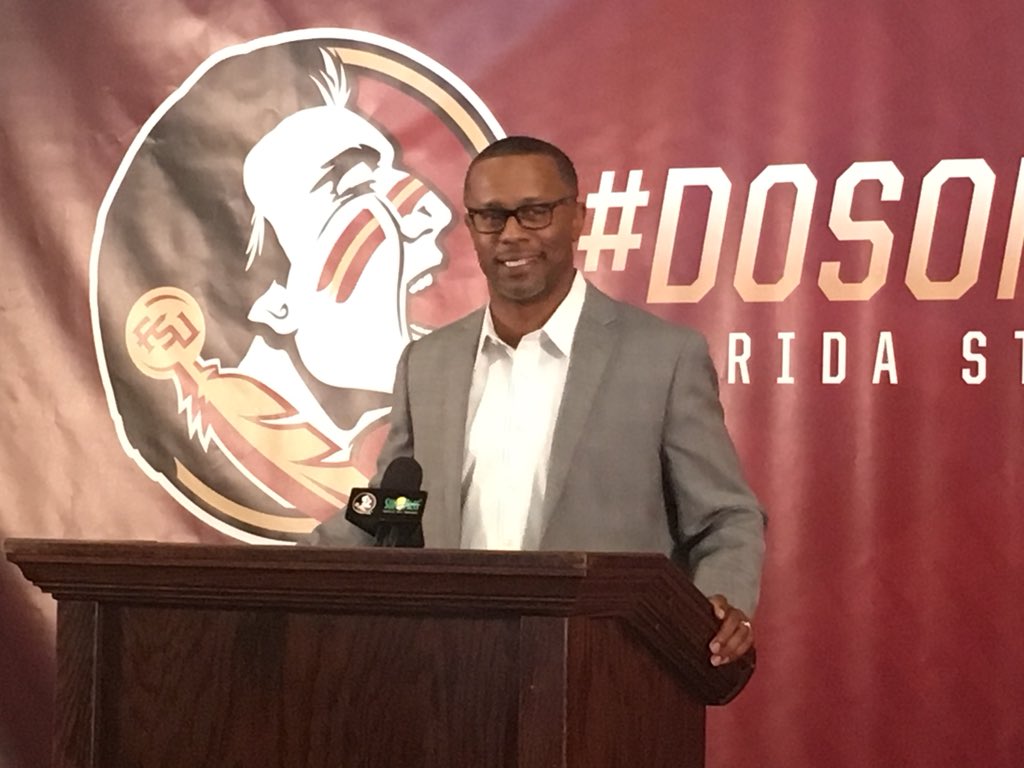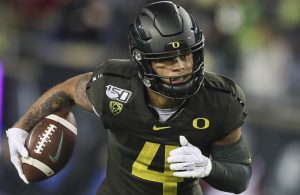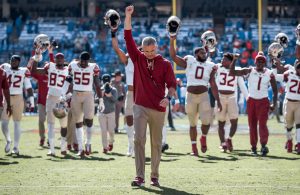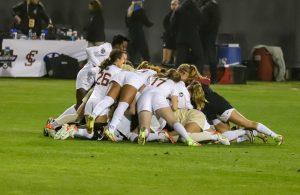- Sunday Seminole Summary: FSU Football Adds Pair of WR Transfers
- Sunday Seminole Summary: FSU Football Exits ESD With Top-15 Class
- Sunday Seminole Summary: FSU Soccer Tops BYU for Third National Championship
- Sunday Seminole Summary: FSU Soccer Advances to National Championship Match
- Seminole Sunday Summary: FSU Soccer Heads Back to College Cup
- Seminole Sunday Summary: FSU Soccer Reaches Sweet 16; Football Tops Boston College
- Seminole Sunday Summary: FSU Soccer Wins ACC, Advances to Second Round of NCAA Tournament; FSU Football Rallies Past Miami
- Seminole Sunday Summary: FSU Soccer Tops Wake on OT to Advance to ACC Final
- Seminole Sunday Summary: FSU Football Crushes UMass for Third Straight Win
- Seminole Sunday Summary: FSU Soccer Stays Perfect with Pair of Wins
Taggart Files: Offensive Performance and Context
- By Clint Eiland
- Updated: February 14, 2018
 Clint Eiland/The Daily Nole
Clint Eiland/The Daily NoleAn interesting situation in the state of Florida has arisen for the first time in over a decade. Amidst the recent coaching changes of 2015 and onward, the “Big 3” programs of Florida State, Florida, and Miami, underwent a shift in philosophy.
Since 2015, all three teams have hired coaches with roots as offensive coordinators. Willie Taggart, Dan Mullen, and Mark Richt are the current iteration of the trend.
It seems like an unimportant piece of trivia at first glance. Surely it didn’t happen by any intentional means. Schools hire coaches based on who they feel can lead them to national titles and who fits into the culture of the program. Whether they’re on the offensive or defensive side of the ball would be a secondary consideration.
But given recent shifts in recruiting, perhaps there’s been a fundamental change in the values that these programs hold. It’s no secret that the state of Florida produces elite football talent, that has always been known.
Yet names like Dalvin Cook, Lamar Jackson, Calvin Ridley, Sony Michel, and others are beginning to put the focus on the offense. It’s not just good offensive talent — it’s elite offensive talent that could change a program’s trajectory if it is able to keep players in-state.
It shouldn’t be surprising then that all of the Big 3 programs in Florida are attempting to build the proverbial fences around the state and hire coaches who could best utilize that talent. How frustrating is it for a team like the Gators to toil in offensive mediocrity when they have an embarrassment of riches surrounding them?
That’s not to say the current era is forever, and there’s no way a defensive-minded coach could succeed. But recent events have pointed towards one conclusion: offensive success is the top priority.
The Seminoles hired Willie Taggart based on a lot of factors. One of the bigger ones being his ability to produce top-tier offenses at both South Florida and Oregon. Taggart’s offensive philosophy has been discussed elsewhere, and some numbers were given to illustrate its various successes and failures.
The aim of this piece is to answer the question: what can fans expect from the offense, and how does it compare to the coaches who will be going against him every year?
Here are the S&P offensive rankings for Taggart’s past four offenses. This ranges from 2014 USF to 2017 Oregon.
- 2014 USF: 111
- 2015 USF: 51
- 2016 USF: 7
- 2017 Oregon: 32
The first year examined has a pretty clear outlier with the 111th ranking. That was Taggart’s second year at USF, where he had been attempting to regain some of the ground that Skip Holtz had given up in his three downturn years as head coach of the Bulls.
Starting in 2015, there begins a huge uptick in the offensive production. Many have attributed this solely to quarterback Quinton Flowers and his spectacular dual-threat ability.
How much responsibility is shared between Flowers and Taggart is hard to accurately examine, but those wishing to credit just one person are typically trying to push a narrative. Flowers is a great quarterback for the system, and his explosive running combined with powerful arm made for a deadly combo.
But looking at Flowers in the 2017 season with head coach Charlie Strong seems to indicate that Taggart certainly did have a role in Flowers’ success.
Consider that in 2016, the quarterback finished with a 62.5 percent completion rate, 2,812 passing yards, 9.0 adjusted yards per attempt, 24 touchdowns, seven interceptions, 1,530 rushing yards, 7.7 yards per rushing attempt and 18 rushing touchdowns.
In 2017, some of the volume stats improve. Flowers threw for 2,911 yards, 25 touchdowns, and six interceptions. But his completion tanks to just above 53 percent, his A/YA drops slightly, and his rushing numbers decline to 1,078 yards, 5.5 yards per attempt, and just 11 rushing touchdowns. The offense as a whole steps back to 27th in the S&P rankings.
The above doesn’t even take into account the progression from 2015 to 2016 (hint: he gets better in every single category). Taggart was able to maximize Flowers’ abilities and lead the USF offense to elite levels. Flowers is a fantastic player who has the tools to succeed in the NFL in some capacity. These two beliefs are not contradictory.
His lone year at Oregon also provides encouraging numbers for Florida State fans. Despite losing both the starting quarterback (Justin Herbert) and the backup quarterback for more than half the season, Taggart was able to bring the Ducks a 32nd overall offensive S&P ranking.
The season prior, they had finished 20th and that was with a healthy Dakota Prukop as the backup. It should also not be surprising that Oregon’s run offense was markedly better this past season compared to the passing offense (33 vs. 51).
When Herbert was in? The Ducks averaged over 47 points per game against Power 5 competition. If you exclude the ridiculous 69-10 beatdown of Oregon State, it still comes out to over 42 points per game.
Obviously the Pac-12 doesn’t contain the best defenses, but flashing that ability against inferior opponents is still a positive sign. Compare that to someone like Jim McElwain or Butch Jones, who repeatedly played close games with much less-talented and much lower-ranked teams.
That’s obviously not the whole story. At times last year, the Oregon offense looked dead in the water without Herbert at quarterback. Taggart struggled to get a consistent offense going, but having a third string quarterback tends to do that to even the best of coaches.
Discussions about play-calling are largely fruitless. College football fans are all too familiar with the blame game that occurs when an offense is underperforming. All of the sudden, it turns out that it’s not the head coach’s fault…it’s the offensive coordinator.
Unless that head coach leaves for another program. Oh, actually he was the one calling plays. Glad that you got him off our hands for us.
Funny how that works.
The larger point is that Taggart has an offense that reflects his potential as a head coach. When he has a quarterback who is able to run his system and stay healthy, his offenses can reach great heights.
He’s proven capable at adjusting parts of his offense to fit his talent, and his run game always remains successful. In fact, his offensive line at South Florida was very impressive with this latter regard. In 2016 it ranked 25th in adjusted line yards and fifth in power success rate.
He can still suffer from stagnation when the injury bug strikes. Neither FSU’s Deondre Francois nor James Blackman are perfect fits for his offense, and he’ll need to figure out the proper balance for the 2018 season when he’s implementing his system.
How does this compare to Dan Mullen and Mark Richt? First, here’s Dan Mullen’s offensive rankings for the past four seasons at Mississippi State.
- 2014 MSU: 8
- 2015 MSU: 16
- 2016 MSU: 32
- 2017 MSU: 63
Oddly enough, one could make the argument that Dak Prescott helped Dan Mullen’s reputation more than Quinton Flowers helped Taggart’s. Ever since Prescott left in 2015, Mullen’s offense got exponentially worse according to the S&P rankings. As always, that’s not the whole story.
The fact that Mullen was able to maintain the 32nd-ranked offense with a freshman quarterback (Nick Fitzgerald) is certainly a mark in his favor. His Mississippi State teams are excellent examples of roster management.
They rarely had an uneven balance of veterans or underclassmen, so there were very few seasons where they bottomed out. This allowed a very consistent offense that could instantly help out whoever stepped in at quarterback.
If there was something to worry about with Mullen’s offense, it would be this past season. Mainly because he returned plenty of experience at the skill positions, including an exceptional quarterback in Nick Fitzgerald. But the Bulldogs had to replace three starting linemen, and apparently that was enough to spark a 30-plus spot drop in the rankings.
Mainly because despite improving in adjusted sack rate, the Bulldogs got worse in adjusted line yards, which is key for rushing success. Mullen excels not through the air, but on the ground.
Florida’s offensive line recruiting over the past three years is sub-par and will be a sore spot when the 2018 season gets into full swing. If the numbers have any connection, the line will also put a ceiling on how much Mullen can improve the Gator offense in his first year.
Finally, Mark Richt. Here’s a look at how the former FSU offensive coordinator’s offenses have fared recently during his tenures as head coach at Georgia and Miami:
- 2014 UGA: 6
- 2015 UGA: 81
- 2016 UM: 34
- 2017 UM: 36
Of all the coaches mentioned in this article, Mark Richt is the most difficult to get a clear read on. His Georgia teams have the dubious distinction of simultaneously being great but disappointing.
Much of that has to do with the offense, which basically collapsed in 2015 after offensive coordinator Mike Bobo left for Colorado State. The Bulldogs had seen enough, and Richt wandered all the way down to Coral Gables for his next coaching gig.
So far the results have been…good. Not great. Not terrible. Just good.
The Hurricanes lost a solid starter at quarterback in Brad Kaaya and replaced him with a not-as-good starter in Malik Rosier. So how did they finish around the same spot in advanced stats, despite scoring around five points less per game? According to those same S&P numbers, rushing greatly improved while Miami’s passing stepped back.
Whatever the Hurricanes lost with Kaaya, they were able to regain on the ground, despite starting running back Mark Walton going down with an injury.
It’s too early to say whether or not Richt has regained his mojo yet. Either Rosier needs to seriously improve, or a new starter needs to emerge, because the Hurricanes were shut down in the final three games of the season when their turnover luck could not rectify a sluggish offense.
Enough high-level talent is returning to win the division once more. If there was ever a time for Richt to prove that he can regain the magic touch, it’s 2018.
Even though all the head coaches are concentrated on offense, the numbers do indicate diversity in their approaches. Taggart has a boom-or-bust potential, with an offense that could reach top 5 status considering the players at his disposal, or mediocre status with just a couple of key injuries.
Mullen has a good consistency that assures the Gator offense will improve from their 2017 low mark, but he also has crucial barriers that could limit his abilities for at least two years. Richt is…quite frankly, it’s tough to say. Everyone will see when 2018 rolls around.
Part of the allure with Taggart remains his potential as a head coach. He adjusted his offensive style at USF when he realized that he had players who could threaten opponents with a more spread-out approach, and his recent hire of Walt Bell from Maryland indicates that he’s willing to get a second pair of eyes to look over his strategy.
Taggart talked a lot about “lethal simplicity” when it came to his potential FSU offense. He understands the frustration experienced when a clearly talented team is wasting elite players.
He also understands that the other two threats to his state supremacy are both in his area of coaching. If he wants to put his foot down and maintain the edge over two of his biggest opponents, he needs to come out swinging in 2018.




You must be logged in to post a comment Login